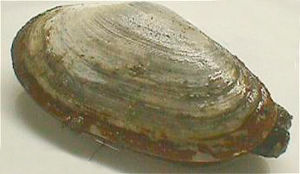Clams
| Clams | ||||||||||||
|---|---|---|---|---|---|---|---|---|---|---|---|---|

Sand gape clam ( Mya arenaria ) |
||||||||||||
| Systematics | ||||||||||||
|
||||||||||||
| Scientific name | ||||||||||||
| Myidae | ||||||||||||
| Lamarck , 1809 |
The clams (Myidae) are a family of mussels from the order of the Myida . The family has been known since the Paleocene .
features
The mostly large housing is equally hinged, also slightly unevenly hinged, and mostly elongated or transversely elliptical, also approximately transversely rectangular. The housing gapes at the rear end, i.e. H. there is a wide gap even when the housing is otherwise closed. It is more or less clearly unequal, the vertebrae sit in front of the center line (based on the length of the case). Lunula and area are not developed.
The lock is toothless or with a cardinal tooth in both flaps. The ligament is mostly internal, in a large and well-trained resilifer . There is a chondrophore in the left valve. There are long, large siphons . As a result, the surface line is deeply indented. Juvenile animals still have a functional byssus gland .
The shell is usually thick, but it can also be very thin. The ornamentation usually consists of ridges parallel to the edge and strips of growth. Radial elements are rather rare. The edges of the case are smooth on the inside.
Geographical distribution and habitat
The clam family is found worldwide. The focus of diversity is in the arctic and temperate zones of the northern hemisphere .
They are mostly burrowing forms that live deeply buried in the sediment in coastal areas of the sea from the tidal range to about 75 meters water depth.
Taxonomy
The taxon was introduced by Jean-Baptiste de Lamarck as Les myaires . Since the name was ascribed to Lamarck in the later Latinization, Lamarck is also considered the author of the taxon in the more recent scientific literature. MolluscaBase assigns the following genera to the family:
- Clams (Myidae Lamarck, 1809 )
The genres have been split up by some authors and divided into sub-genres. MolluscaBase does not follow the strong fragmentation of the genus by some authors.
supporting documents
literature
- Michael Amler, Rudolf Fischer & Nicole Rogalla: Mussels . Haeckel library, volume 5. Enke Verlag, Stuttgart 2000 ISBN 3-13-118391-8 .
- Rudolf Kilias: Lexicon marine mussels and snails. 2nd edition, 340 p., Verlag Eugen Ulmer, Stuttgart 1997 ISBN 3-8001-7332-8 (p. 207)
- Raymond Cecil Moore (Ed.): Treatise on invertebrate paleontology. Mollusca, 6, Part N, Bivalvia 2. XXXVIII S., S.N491-951, New York, 1969 (S.N691 / 2).
- Fritz Nordsieck : The European sea shells (Bivalvia). From the Arctic Ocean to Cape Verde, the Mediterranean Sea and the Black Sea. 256 pages, Gustav Fischer Verlag, Stuttgart 1969
- Guido Poppe and Yoshihiro Goto: European Seashells Volume 2 (Scaphopoda, Bivalvia, Cephalopoda) . 221 p., Verlag Christa Hemmen, Wiesbaden 1993 (2000 unc. Reprint), ISBN 3925919104 (p. 127/8)
Individual evidence
- ^ Jean-Baptiste de Lamarck: Philosophy zoologique. Vol. 1, XXV + 428 S., Dentu, Paris, 1809 Online at Google Books (p. 319).
- ↑ a b MolluscaBase: Myidae Lamarck, 1809
- ^ Raymond Cecil Moore (Ed.): Treatise on invertebrate paleontology. Mollusca, 6, Part N, Bivalvia 2. XXXVIII S., S.N491-951, New York, 1969 (S.N691 / 2).